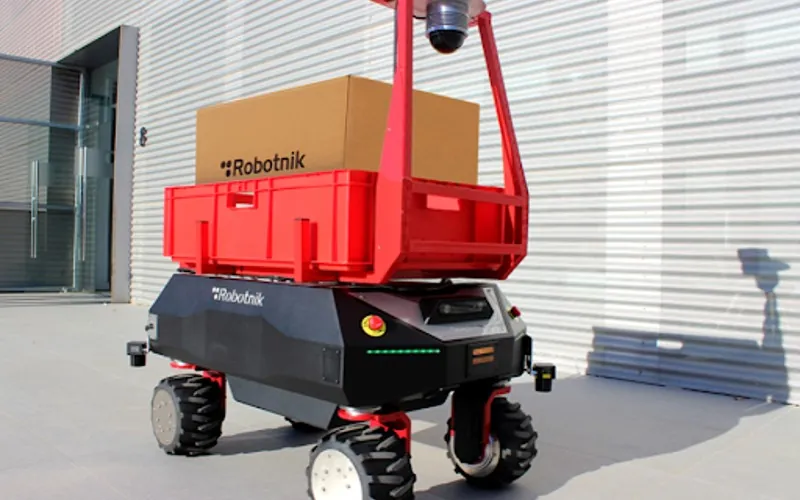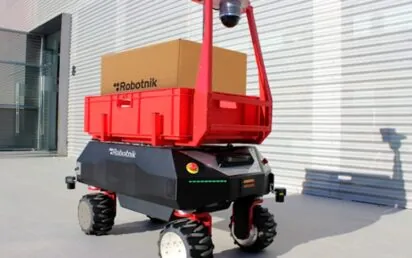Autonomous mobile robots (AMRs) have revolutionized industries ranging from logistics to healthcare. These sophisticated machines navigate their environments without human intervention, optimizing processes and enhancing efficiency. One notable player in this domain is Robotnik, a company renowned for its innovative mobile platforms and manipulators.
The advent of AMRs has been a game-changer, driven by advancements in technology and the increasing demand for automation. Unlike traditional robots, which operate in fixed locations, autonomous mobile robots can move freely, making them ideal for dynamic environments. This flexibility has opened up new possibilities in various sectors, including manufacturing, warehousing, and even agriculture.
The concept of mobile robotics is not new; it has evolved over decades. Early iterations were often limited by their dependency on predefined paths and manual controls. However, the integration of sophisticated sensors, powerful processors, and advanced algorithms has enabled the creation of truly autonomous systems. Modern AMRs are capable of navigating complex environments, avoiding obstacles, and adapting to changes in real-time, all while performing a variety of tasks.
Key technologies driving AMRs
Several cutting-edge technologies underpin the functionality of AMRs:
1. Lidar and Computer Vision: These technologies enable robots to perceive their surroundings, avoid obstacles, and navigate complex environments. Lidar systems use laser beams to create detailed 3D maps, while computer vision employs cameras and image processing algorithms to interpret visual data. Together, they provide AMRs with the situational awareness necessary for safe and efficient operation.
2. Artificial Intelligence (AI): AI algorithms facilitate decision-making processes, allowing robots to adapt to changing conditions and optimize their routes. Machine learning techniques enable AMRs to learn from their experiences, improving their performance over time. AI also plays a crucial role in coordinating multiple robots, ensuring they work together seamlessly.
3. Internet of Things (IoT): IoT connectivity allows robots to communicate with other devices and systems, enhancing coordination and efficiency. By integrating with IoT networks, AMRs can access real-time data from various sources, such as sensors and other robots. This connectivity enables them to make informed decisions, respond to environmental changes, and collaborate with other systems.
4. Advanced Control Systems: Modern control systems provide precise control over robot movements and actions. These systems integrate inputs from various sensors and process them in real-time, allowing AMRs to execute complex tasks with high accuracy. Advanced control algorithms also ensure smooth and efficient operation, even in challenging environments.
Robotnik’s contributions to Mobile Robotics
Robotnik has been at the forefront of mobile robotics for years, developing advanced platforms that cater to various industrial needs. Their expertise extends beyond manufacturing to include engineering and R&D projects, cementing their status as a reference company in the field.
One of significant achievements is in the realm of mobile manipulators. These versatile robots combine mobility with the capability to manipulate objects, making them invaluable in tasks such as material handling and assembly. Mobile manipulators can navigate through warehouses or factories, pick up items, and place them in designated locations, all without human intervention. This level of automation significantly enhances productivity and reduces operational costs.
Robotnik’s product portfolio includes a range of mobile robots designed for different applications. For instance, their SUMMIT-XL robot is a robust and versatile platform that can be customized for various tasks, from inspection and surveillance to logistics and transportation. The RB-1 BASE, another of their products, is a compact and agile robot ideal for indoor environments. These platforms are equipped with state-of-the-art sensors and control systems, ensuring reliable and efficient performance.
The company’s commitment to innovation is evident in its continuous development of cutting-edge solutions that meet the evolving demands of different industries. Also invests heavily in research and development, collaborating with academic institutions and research centers to push the boundaries of what is possible in mobile robotics. Their involvement in various European and international projects demonstrates their dedication to advancing the field.
Advancements in mobile Robotics Software
The software behind AMRs is as crucial as the hardware. Recent advancements have focused on enhancing the autonomy, reliability, and scalability of these systems. Robotnik has played a pivotal role in this area, contributing to software developments that improve robot coordination and efficiency. Their mobile robotics software solutions are designed to integrate seamlessly with existing systems, providing a robust framework for various applications.
Robotnik’s software platform includes tools for navigation, perception, and control, enabling users to develop customized applications for their specific needs. The software supports various programming languages and frameworks, making it accessible to a wide range of developers. Additionally, provides simulation tools that allow users to test and validate their applications in a virtual environment before deploying them in the real world.
One of the key features of software is its modularity. Users can easily add or remove modules based on their requirements, ensuring flexibility and scalability. The software also supports cloud-based services, enabling remote monitoring and control of AMRs. This capability is particularly valuable in large-scale operations, where centralized management can significantly enhance efficiency.
Applications of AMRs
The applications of AMRs are vast and continually expanding and robots should make workers richer and more secure. In logistics, for example, AMRs are used to transport goods within warehouses, reducing the need for human labor and increasing throughput. These robots can autonomously navigate through warehouse aisles, pick up items from shelves, and deliver them to packing stations. This automation streamlines operations, reduces errors, and enhances overall productivity.
In healthcare, AMRs assist in transporting medical supplies and equipment, ensuring timely delivery and reducing the risk of contamination. Hospitals use these robots to move medications, lab samples, and sterile instruments, freeing up staff to focus on patient care. AMRs can also be used in eldercare facilities to deliver meals and other necessities, improving the quality of life for residents.
Agriculture is another sector benefiting from AMRs. Robots can perform tasks such as planting, harvesting, and monitoring crops, thereby increasing productivity and reducing the environmental impact. Autonomous tractors and harvesters can work around the clock, optimizing field operations and reducing labor costs. Additionally, AMRs equipped with sensors can collect data on soil conditions, plant health, and weather, enabling farmers to make informed decisions and improve crop yields.
Other industries, such as mining, construction, and security, are also exploring the use of AMRs. In mining, robots can navigate hazardous environments, perform inspections, and transport materials, enhancing safety and efficiency. In construction, AMRs can assist in tasks such as bricklaying, concrete pouring, and site inspection, accelerating project timelines and reducing labor costs. Security robots can patrol large areas, monitor for intrusions, and provide real-time surveillance, enhancing safety and security.
Looking ahead
The future of autonomous mobile robots is bright, with ongoing research and development promising even more advanced capabilities. As companies like Robotnik continue to innovate, we can expect AMRs to become even more integral to various industries, driving efficiency and enabling new levels of productivity.
Emerging trends such as collaborative robots (cobots), which work alongside humans, and swarm robotics, where multiple robots collaborate to complete tasks, are set to redefine the landscape of mobile robotics. Cobots can assist human workers in tasks that require precision and dexterity, while swarm robotics can handle large-scale operations that require coordination among multiple units.
Moreover, advancements in artificial intelligence and machine learning will further enhance the autonomy and intelligence of AMRs. Future robots will be able to learn from their experiences, adapt to new environments, and perform increasingly complex tasks. The integration of 5G connectivity will also enable faster and more reliable communication between robots and other systems, enhancing their performance and capabilities.
In conclusion, autonomous mobile robots represent a significant leap forward in automation technology. With pioneers leading the charge, the potential applications and benefits of these machines are limitless. By embracing these advancements, industries can not only enhance their operations but also pave the way for a more automated and efficient future.


